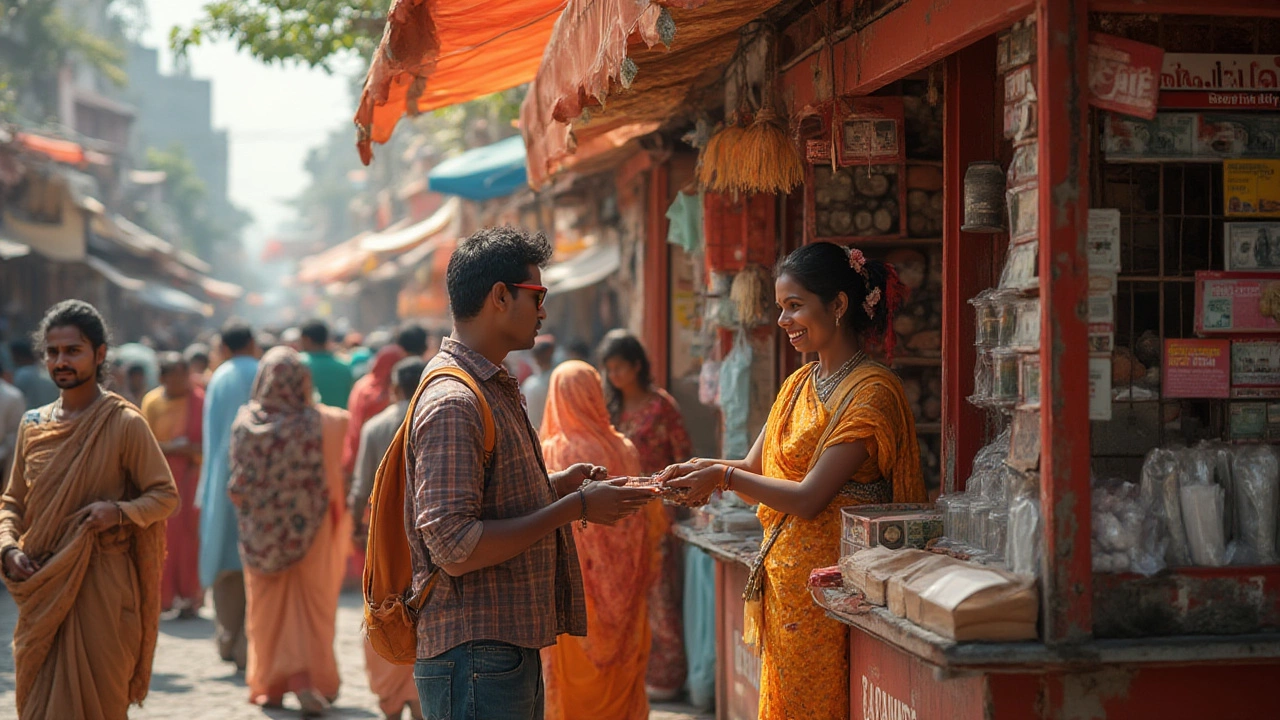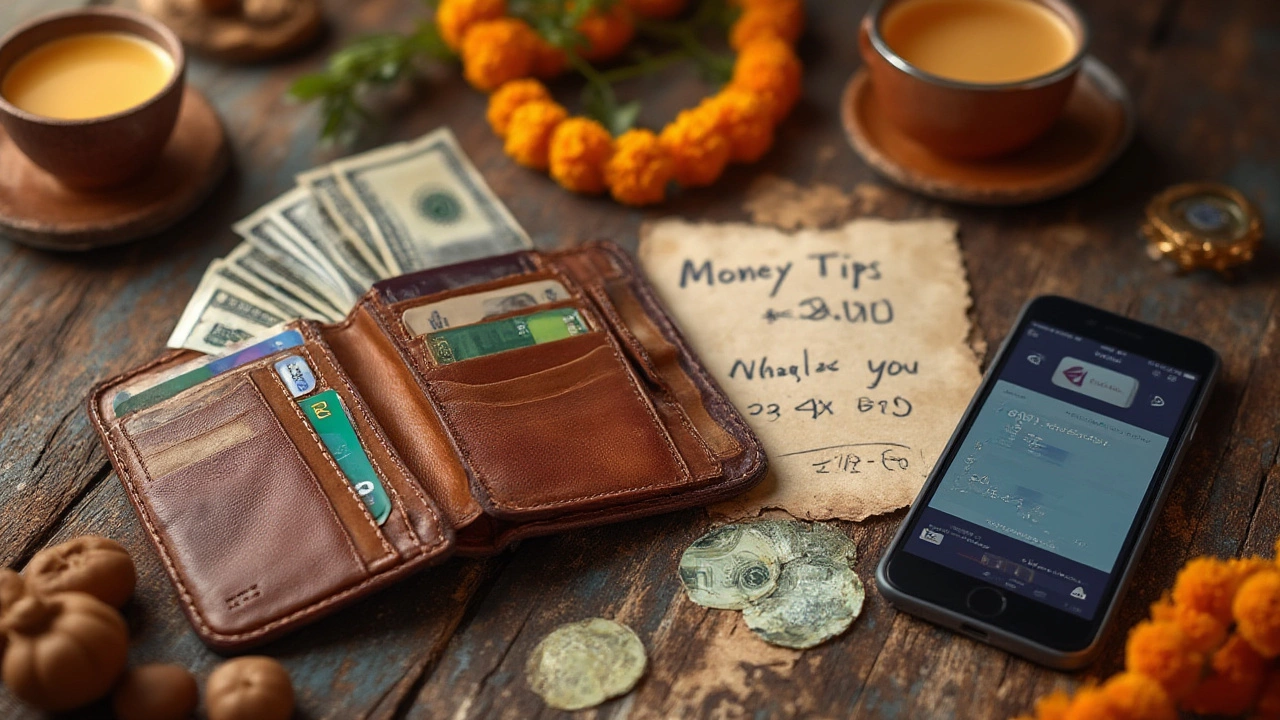How Much is $1 US Dollar Worth in India? Exchange Rate, Practical Tips & Travel Insights
 Jul, 26 2025
Jul, 26 2025
A single US dollar isn’t just a piece of green paper in India—it’s your invite to a world where the math is never quite as simple as the figure you see on Google. Currency? Sure. But it’s also your bargaining chip, your coffee fund, or even your unlock code for new adventures, whether you’re hunting for the best paneer tikka or squishing into a Mumbai local train. If you’re asking yourself, “How much is a dollar worth in India today?”—well, that small question opens a door to shifting rates, hidden fees, street vendor haggling, and real-deal purchasing power. Ready for the ride?
What is the Current Exchange Rate for $1 US Dollar in India?
Numbers don’t stand still, especially not in the money markets. As of July 26, 2025, the US dollar to INR exchange rate averaged 84.7 INR per $1 USD, according to data from the Reserve Bank of India. But don’t just take my word for it. Rates bob up and down all day, and the price you see on Google or currency apps is usually the “interbank rate”—it’s what big banks trade with, not what travelers actually get at the cashier’s desk. What you’ll really get is usually a little bit less, thanks to service fees and commission.
Let’s put the current exchange rate in a simple table so you have something concrete to go on:
| Date | 1 USD in Indian Rupees (INR) | Source |
|---|---|---|
| July 26, 2025 | 84.7 | Reserve Bank of India |
Here’s an important catch: what you get at the airport, hotel, or a street exchange booth often lags behind. You might get 83 or even 82 INR per US dollar after commission or service charges, especially at airports or hotels known for their convenience but not for generosity. For the best rates, head to reputable money changers in city markets, or use your debit card at a local ATM (just be sure you know what your home bank charges for foreign withdrawals).
So, does one dollar have the same impact in a Delhi bazaar as it does at a Dunkin’ Donuts in New York? Nope. The real “value” of that dollar depends on both the exchange rate and what you’re buying. It’s easy to imagine that 84 rupees will go further, but that also fades fast in fancier parts of Mumbai or when paying for imports.
How the US Dollar Holds Its Power—And Where It Doesn’t
Let’s get into why $1 can mean very different things depending on the street you’re standing on and what day it is. India is a wild blend of affordable pleasures and “big city” splurges. Take a bottle of water—at a local shop, it might set you back 20 INR (that’s about $0.24). A ride in an autorickshaw across town for 3 kilometers: around 40 INR, less than $0.50. A solid full lunch at a small restaurant? 150 INR, not even $2. Chanawala at a street stall? Barely pocket change, maybe 30 INR.
But drop into a fancy coffee chain in a big city, and that cappuccino may cost you 250 INR (nearly $3). Why the difference? Urban rents, imported ingredients, and, honestly, ‘experience pricing.’ Want to buy a movie ticket at a nice multiplex in South Delhi? Expect to pay around 400 INR ($4.70 on today’s rate).
A lot of visitors are surprised at the price swings. Still, if you stick to local markets, street food, train rides, and public transport, $1 can do more heavy lifting in India than almost anywhere else. You’ll get genuine local flavor—literally and figuratively. If you’re craving international brands, American fast food, or global gadgets, then the power slips away pretty fast and that “cheaper India” feel just vanishes.
“Tourists are often amazed at how far their money goes, but it depends where and how you spend it. Local food and transport deliver real value, while imported goods carry a premium,” notes Suresh Sharma, a senior economist at the Centre for Policy Research in New Delhi.
Think of the Indian rupee not as some flat fixed number, but a fast-moving measure of what you want out of your trip. If you’re picky about Western habits or need imported spirits or tech, budget extra. If you’re game for fresh mangoes off a cart or a train-route samosa, the rupee’s power will make you smile.

Practical Tips: Exchanging Money and Getting the Best Value
Switching your dollars to rupees seems simple—swap, smile, move on. But there’s more to it if you want to get the best deal. Here are some solid, real-world tricks for turning your greenbacks into maximum curry money.
- Don’t change big wads at the airport. The airport rates are notoriously lousy, with high commission. If you must get rupees there, only exchange enough for your taxi and first meal.
- Bring some cash from home…but don’t carry a huge bundle. India's cash economy is still alive and well, but you’ll get far better rates from ATMs inside the country. International withdrawal fees do add up, so check with your bank before flying. Most card brands (Visa, Mastercard) are widely accepted in cities, but cash is still king in rural areas or local markets.
- Prefer ATMs over exchange counters. Withdrawals from local Indian ATMs usually give you a solid market rate, minus a small fee. Popular banks with foreigner-friendly ATMs include SBI, ICICI, HDFC, and Axis.
- Use reputable money exchangers. Thomas Cook India and Muthoot Forex have a presence in most big cities and airports. You get receipts and see the published rate (just check that day’s average online first).
- Watch your small notes. It's all about “change.” Even in 2025, getting stuck with only 2,000 rupee notes can make street payments awkward. Always ask for a decent stack of 100s, 50s, and 10s—street vendors and rickshaws almost never have change.
- Check real-time rates on your phone. XE.com and OANDA offer reliable, live currency rates, so you can double-check before you swap or withdraw.
- Digital payments are growing. In cities, UPI (Unified Payments Interface) is everywhere. Many foreign tourists now buy a local SIM card and set up apps like Google Pay or Paytm with their Indian bank-issued prepaid cards. You can even pay for tea, taxis, and mangoes with your phone in 2025.
When you’re wandering Indian streets, it pays to ask if an item has a “MRP”—Maximum Retail Price. That’s the government-capped price for packaged goods, printed right on the label. It prevents “tourist pricing” on water bottles and snacks, so you know you’re not being taken for a ride.
Planning to bring back souvenirs? Remember, a $10 wooden elephant statue at a street market might fetch $100 back home. Bargaining is expected—start low, keep a friendly face, and settle for a fair deal.
If you want a quick conversion estimate for your daily spending, here’s a user-friendly chart for 2025 rates:
| US Dollars | Approx. INR (2025) |
|---|---|
| $1.00 | 84.7 |
| $5.00 | 423.5 |
| $10.00 | 847.0 |
| $50.00 | 4,235.0 |
| $100.00 | 8,470.0 |
Making Your Money Work—Everyday Buying Power in India
When you break down what a dollar can buy, context is everything. If you’re exploring Rajasthan, $1 might get you an hour of cycle rickshaw, two spicy samosas, a big chai, and a smile. In Goa, it might just get you a can of cola at a beach shack. Here’s a rough guide to common spending experiences, with 2025 pricing, to show how far a single buck really goes:
- Bottle of water (1 liter): 20 INR ($0.24)
- Street samosa or aloo tikki: 25–40 INR ($0.29–$0.47)
- Local bus ticket: 20 INR ($0.24)
- Short metro trip in Delhi or Bangalore: 30 INR ($0.35)
- Rikshaw ride (2 to 3 km): 40-60 INR ($0.47–$0.71)
- A basic thali (full meal): 130 INR ($1.53)
- Entry to a small monument or museum: 50 INR ($0.59)
- 10 bananas at a local fruit market: 70 INR ($0.83)
- Entry to Taj Mahal (for foreign tourists): 1300 INR ($15.35)
For a solo budget traveler, $25 a day can mean eating well, moving around cities, and checking out basic sights. If high-end hotels and international cuisine are your thing, plan on $100+ a day—sometimes much more in prime locations like South Mumbai or Delhi's upscale neighborhoods.
The most striking fact? Despite inflation and rapid tech growth, India still delivers serious bang for your buck in 2025. Sure, the price of electronics, fuel, and luxury items inch up each year, but daily expenses—especially if you stick to local brands and markets—give US visitors an affordable and seriously rich travel experience.
Here’s one last pro tip if you want the most from your wallet: Talk to locals. Ask what things should cost before you buy. Locals are usually happy to clue you in, and you’ll avoid the dreaded “tourist markup.” That way, your dollar buys adventure, not just a transaction.